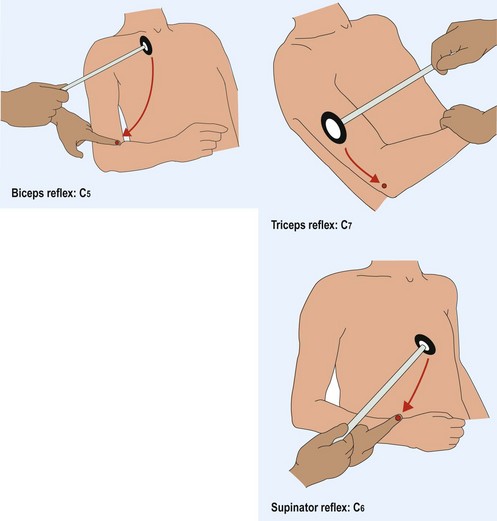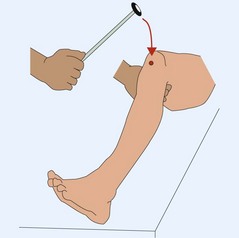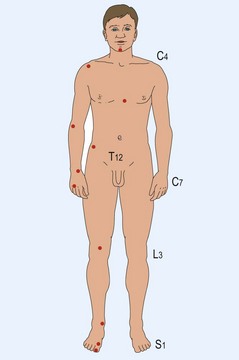Limbs
reflexes and sensation
How to elicit tendon reflexes
The patient needs to be relaxed, with the muscle to be tested in the middle of its range of movement (Figs 1–3). The tendon hammer is swung to hit the tendon or, for the biceps and supinator reflexes, a finger on the tendon. The muscle is watched for movement in response to this. If the reflex is not obtainable then the patient is asked either to clench the teeth or make a fist – reinforcement – which may allow the reflex to be found. When testing the reflexes it is useful to remind yourself of the segmental level being tested.
Sensory examination
This section will describe some background and the techniques of sensory testing. The findings and their interpretation are discussed on pages 60–61.
Vibration sense
 Teach: Set off the tuning fork and apply this to the sternum to allow the patient to experience the feeling of vibration.
Teach: Set off the tuning fork and apply this to the sternum to allow the patient to experience the feeling of vibration. Test: Ask the patient whether the vibration is felt when it is applied to the bony prominences (Fig. 4). If this is perceived distally, there is no need to proceed proximally.
Test: Ask the patient whether the vibration is felt when it is applied to the bony prominences (Fig. 4). If this is perceived distally, there is no need to proceed proximally.Joint position sense
When testing joint position sense, hold the joint so that your grip is perpendicular to the direction of joint movement (Fig. 5). Normally, small movements are perceived. Testing patients without neurological problems allows you to establish a ‘normal range’.
 Test: With the patient’s eyes closed, move the joint up and down, asking the patient to tell you the direction of movement. Start with large movements and gradually reduce them until the patient makes errors.
Test: With the patient’s eyes closed, move the joint up and down, asking the patient to tell you the direction of movement. Start with large movements and gradually reduce them until the patient makes errors.Pinprick
 Teach: Touch an area of clinically unaffected skin with a pin and inform the patient that ‘this is a pin’.
Teach: Touch an area of clinically unaffected skin with a pin and inform the patient that ‘this is a pin’.



















